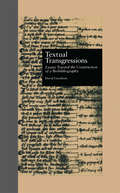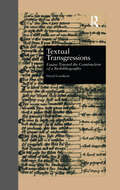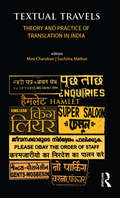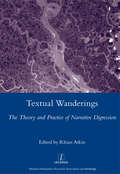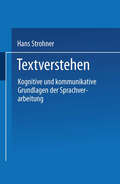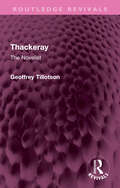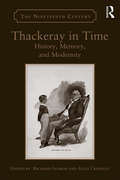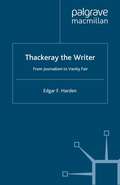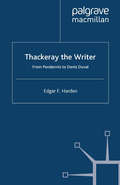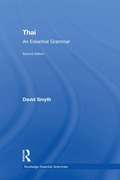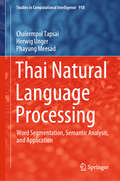- Table View
- List View
Textual Transgressions: Essays Toward the Construction of a Biobibliography
by David GreethamFirst published in 1998. Routledge is an imprint of Taylor & Francis, an informa company.
Textual Transgressions: Essays Toward the Construction of a Biobibliography
by David GreethamFirst published in 1998. Routledge is an imprint of Taylor & Francis, an informa company.
Textual Travels: Theory and Practice of Translation in India
by Mini Chandran Suchitra MathurThis book presents a comprehensive account of the theory and practice of translation in India in combining both its functional and literary aspects. It explores how the cultural politics of globalization is played out most powerfully in the realm of popular culture, and especially the role of translation in its practical facets, ranging from the fields of literature and publishing to media and sports.
Textual Travels: Theory and Practice of Translation in India
by Mini Chandran Suchitra MathurThis book presents a comprehensive account of the theory and practice of translation in India in combining both its functional and literary aspects. It explores how the cultural politics of globalization is played out most powerfully in the realm of popular culture, and especially the role of translation in its practical facets, ranging from the fields of literature and publishing to media and sports.
Textual Wanderings: The Theory and Practice of Narrative Digression
by Rhian Atkin"Digression is a crucial motif in literary narratives. It features as a key characteristic of fictional works from Cervantes and Sterne, to Proust, Joyce and Calvino. Moving away from a linear narrative and following a path of associations reflects how we think and speak. Yet an author's inability to stick to the point has often been seen to detract from a work of literature, somehow weakening it. This wide-ranging and timely volume seeks to celebrate narrative digressions and move towards a theoretical framework for studying the meanderings of literary texts as a useful and valuable aspect of literature. Essays discussing some of the possibilities for approaching narrative digression from a theoretical perspective are complemented with focused studies of European and American authors. As a whole, the book offers a broad and varied view of textual wanderings."
Textual Wanderings: The Theory and Practice of Narrative Digression
by Rhian Atkin"Digression is a crucial motif in literary narratives. It features as a key characteristic of fictional works from Cervantes and Sterne, to Proust, Joyce and Calvino. Moving away from a linear narrative and following a path of associations reflects how we think and speak. Yet an author's inability to stick to the point has often been seen to detract from a work of literature, somehow weakening it. This wide-ranging and timely volume seeks to celebrate narrative digressions and move towards a theoretical framework for studying the meanderings of literary texts as a useful and valuable aspect of literature. Essays discussing some of the possibilities for approaching narrative digression from a theoretical perspective are complemented with focused studies of European and American authors. As a whole, the book offers a broad and varied view of textual wanderings."
The Textuality of Soulwork: Jack Kerouac's Quest for Spontaneous Prose (Editorial Theory And Literary Criticism)
by Timothy HuntTim Hunt’s The Textuality of Soulwork: Jack Kerouac’s Quest for Spontaneous Proseexamines Kerouac’s work from a new critical perspective with a focus on the author’s unique methods of creating and working with text. Additionally, The Textuality of Soulwork delineates Kerouac’s development of “Spontaneous Prose” to differentiate the preliminary experiment of On the Road from the more radical experiment of Visions of Cody, and to demonstrate Kerouac’s transition from working within the textual paradigm of modern print to the textual paradigm of secondary orality. From these perspectives, Tim Hunt crafts a new critical approach to Beat poetics and textual theory, marking an important contribution to the current revival of Kerouac and Beat studies underway at universities in the U.S. and abroad, as reflected by a growing number of conferences, courses, and a renewal in scholarship.
Textuelle Dramaturgie: Eine Methode der Theatertextanalyse
by Kerstin MertenskötterEin Blick in die aktuellen Spielpläne der Theater der Gegenwart offenbart ein offenes und hetero-genes Feld an Textformen und Inszenierungsweisen. Klassische Dramen und traditionelle Insze-nierungen finden sich neben postdramatischen Arbeiten und der Ästhetik der Neudramatik. Das Postdramatische Theater und ebensolche Texte, etwa von Elfriede Jelinek, Peter Handke oder René Pollesch stehen dabei im Kontext ihrer Aufkündigung mit dem „Dreigestirn von Drama, Handlung und Nachahmung“, wie Hans-Thies Lehmann es in seiner Monografie "Postdramatisches Theater" beschreibt. Dies führt zu einer Entpersonalisierung der Figuren, zu einer Monologisierung der Dialogstruktur, zu einem Bruch mit dem Anspruch auf kausal-logische Wiedergabe eines ‚Geschehens‘. Doch die an der aristotelischen Poetik und dem Drama des 18. Jahrhunderts ausgerichtete Methode der Dramenanalyse kann (aktuelle) Theatertexte, die ohne Handlung und Figuren auskommen, nicht oder nur ex negativo erfassen. Kerstin Mertenskötter entwickelt eigene, erweiterte und revidierte literaturwissenschaftliche Analysebegriffe. Die Methode der Theatertextanalyse ermöglicht es, sowohl einen produktiven analytischen Zugang zu post- und neudramatischen Theatertexten zu erlangen, wie auch dramaturgische Verfahren in Theatertexten des 18. und 19. Jahrhunderts zu entdecken.
The Texture of Culture: An Introduction to Yuri Lotman’s Semiotic Theory (Semiotics and Popular Culture)
by A. SemenenkoIn this introduction to the semiotic theory of one of the most innovative theorists of the twentieth century, the Russian literary scholar and semiotician Yuri Lotman, offers a new look at Lotman's profound legacy by conceptualizing his ideas in modern context and presenting them as a useful tool of cultural analysis.
The Texture of the Lexicon: Relational Morphology and the Parallel Architecture
by Ray Jackendoff Jenny AudringIn this volume, Ray Jackendoff and Jenny Audring embark on a major reconceptualization of linguistic theory as seen through the lens of morphology. Their approach, Relational Morphology, extends the Parallel Architecture developed by Jackendoff in Foundations of Language (2002), Simpler Syntax (2005), and Meaning and the Lexicon (2010). The framework integrates morphology into the overall architecture of language, enabling it to interact insightfully with phonology, syntax, semantics, and above all, the lexicon. The first part of the book situates morphology in the language faculty, and introduces a novel formalism that unifies the treatment of all morphological patterns, inflectional or derivational, systematic or marginal. Central to the theory is the lexicon, which both incorporates the rules of grammar and explicitly encodes relationships among words and among grammatical patterns. Part II puts the theory to the test, applying it to a wide range of familiar and less familiar morphological phenomena. Part III connects Relational Morphology with issues of language processing and language acquisition, and shows how its formal tools can be extended to a variety of linguistic and nonlinguistic phenomena outside morphology. The value of Relational Morphology thus lies not only in the fact that it can account for a range of morphological phenomena, but also in how it integrates linguistic theory, psycholinguistics, and human cognition.
Textverstehen: Kognitive und kommunikative Grundlagen der Sprachverarbeitung (Psycholinguistische Studien)
by Hans StrohnerTextverstehen ist ein grundlegender Teil der menschlichen Sprachverarbeitung und beinhaltet einen kognitiven und einen kommunikativen Aspekt. Der kognitive Aspekt bezieht sich auf die Informationsverarbeitung im Textrezipienten, während der kommunikative Aspekt das durch das Textverstehen bewirkte gemeinsame Wissen der Kommunikationspartner umfaßt. Sowohl in kognitiver als auch in kommunikativer Hinsicht geht es beim Textverstehen vor allem um die Herstellung von Sinn. Zum einen ist dies semantischer Sinn, der Ordnung im Weltwissen schafft, zum anderen pragmatischer Sinn, der die Beziehungen zwischen den Kommunikationspartnern regelt und so die Grundlage für die soziale Verständigung bildet. Diese Kernaussage des Buchs wird mit Hilfe einer systemtheoretischen Begrifflichkeit vorbereitet und in ihren verschiedenen theoretischen und empirischen Aspekten ausführlich diskutiert und belegt.
Thackeray: The Novelist (Routledge Revivals)
by Geoffrey TillotsonFirst published in 1954, Thackeray is intended as a reminder that Thackeray is, after all, a great novelist. Professor Tillotson, admiring the novels as great literature, explores their common characteristics and those they share with the rest of Thackeray’s writings – for he sees Thackeray’s work as all of a piece. He is particularly interested in Thackeray’s methods of narration and in the philosophic commentary which forms a sort of trellis for almost everything he put out. He sees him mainly as a writer who, subtle as he is, address himself to readers honoured as ordinary human beings. In two appendices, Professor Tillotson deals with two particular modern opinions – that Thackeray spoiled his novels by an ‘infiltration’ into them of his own biography, and that he has no place in the great novel tradition. This book will be of interest to students of literature and history.
Thackeray: The Novelist (Routledge Revivals)
by Geoffrey TillotsonFirst published in 1954, Thackeray is intended as a reminder that Thackeray is, after all, a great novelist. Professor Tillotson, admiring the novels as great literature, explores their common characteristics and those they share with the rest of Thackeray’s writings – for he sees Thackeray’s work as all of a piece. He is particularly interested in Thackeray’s methods of narration and in the philosophic commentary which forms a sort of trellis for almost everything he put out. He sees him mainly as a writer who, subtle as he is, address himself to readers honoured as ordinary human beings. In two appendices, Professor Tillotson deals with two particular modern opinions – that Thackeray spoiled his novels by an ‘infiltration’ into them of his own biography, and that he has no place in the great novel tradition. This book will be of interest to students of literature and history.
Thackeray and Form of Fiction
by John LoofbourowIn a critical examination of Thackeray's style, Mr. Loofbourow shows how Thackeray "hybridized" the genre of the romance by adapting the tone and language of the epic, the chivalric romance, and the pastoral, and by carrying parody and satire to a high technical level. Thackeray used these techniques with particular success in Vanity Fair and Henry Esmond. Besides analyzing these two works, Mr. Loofbourow discusses the significance of epic in the 19th century, the expressive values of the novel as a whole, and the relevance of Thackeray’s methods to the work of such writers as George Eliot, Henry James, Virginia Woolf, and E. M. Forster. His book is an attempt to come to terms with Thackeray’s style, and a work conceivably destined to become a landmark among the very few acceptable studies of English fiction. It should prove indispensable to anyone interested in style in fiction, and should at the same time precipitate a new trend in Thackeray scholarship.Originally published in 1964.The Princeton Legacy Library uses the latest print-on-demand technology to again make available previously out-of-print books from the distinguished backlist of Princeton University Press. These editions preserve the original texts of these important books while presenting them in durable paperback and hardcover editions. The goal of the Princeton Legacy Library is to vastly increase access to the rich scholarly heritage found in the thousands of books published by Princeton University Press since its founding in 1905.
Thackeray at Work (Bloomsbury Academic Collections: English Literary Criticism)
by J. A. SutherlandThe study of Thackeray's major fiction reconstructs the novelist's working methods with the help of manuscript material, much of it previously unpublished. The book's main argument is directed against the commonplace view that Thackeray was in some way a 'careless' artist. Much that appears casual or unpremeditated in his work can in fact be explained by the mode of composition which he developed in response both to the publishing conditions of his age and to his own artistic temperament. An appreciation of Thackeray's writing habits helps clear up much of the critical confusion which has surrounded his reputation in the last hundred years. A particular feature of interest in the book is the use made of Thackeray's preparatory working materials. These were widely dispersed after the writer's death and have never been comprehensively examined.
Thackeray in Time: History, Memory, and Modernity (The Nineteenth Century Series)
by Richard Salmon Alice CrossleyAn intense fascination with the experience of time has long been recognised as a distinctive feature of the writing of William Makepeace Thackeray (1811–1863). This collection of essays, however, represents the first sustained critical examination of Thackeray's 'time consciousness' in all its varied manifestations. Encompassing the full chronological span of the author's career and a wide range of literary forms and genres in which he worked, Thackeray in Time repositions Thackeray's temporal and historical self-consciousness in relation to the broader socio-cultural contexts of Victorian modernity. The first part of the collection focusses on some of the characteristic temporal modes of professional authorship and print culture in the mid-nineteenth century, including periodical journalism and the Christmas book market. Secondly, the volume offers fresh approaches to Thackeray's acknowledged status as a major exponent of historical fiction, reconsidering questions of historiography and the representation of place in such novels as Vanity Fair and Henry Esmond. The final part of the collection develops the central Thackerayan theme of memory within four very different but complementary contexts. Thackeray's absorption by memories of childhood in later life leads on to his own subsequent memorialisation by familial descendants and to the potential of digital technology for preserving and enhancing Thackeray's print archive in the future, and finally to the critical legacy perpetuated by generations of literary scholars since his death.
Thackeray in Time: History, Memory, and Modernity (The Nineteenth Century Series)
by Richard Salmon Alice CrossleyAn intense fascination with the experience of time has long been recognised as a distinctive feature of the writing of William Makepeace Thackeray (1811–1863). This collection of essays, however, represents the first sustained critical examination of Thackeray's 'time consciousness' in all its varied manifestations. Encompassing the full chronological span of the author's career and a wide range of literary forms and genres in which he worked, Thackeray in Time repositions Thackeray's temporal and historical self-consciousness in relation to the broader socio-cultural contexts of Victorian modernity. The first part of the collection focusses on some of the characteristic temporal modes of professional authorship and print culture in the mid-nineteenth century, including periodical journalism and the Christmas book market. Secondly, the volume offers fresh approaches to Thackeray's acknowledged status as a major exponent of historical fiction, reconsidering questions of historiography and the representation of place in such novels as Vanity Fair and Henry Esmond. The final part of the collection develops the central Thackerayan theme of memory within four very different but complementary contexts. Thackeray's absorption by memories of childhood in later life leads on to his own subsequent memorialisation by familial descendants and to the potential of digital technology for preserving and enhancing Thackeray's print archive in the future, and finally to the critical legacy perpetuated by generations of literary scholars since his death.
Thackeray the Writer: From Journalism to Vanity Fair
by E. HardenThis book conveys Thackeray's development as a book reviewer, journalist, art exhibition critic, short-story writer, satirical essayist and novelist a development that culminates in the creation of his masterpiece, Vanity Fair one of the glories of English imaginative writing. Articulating the connections between these vigorous and lively youthful works, and the growth of Thackeray as an increasingly profound participant observer, Harden reveals the exuberant imaginative growth and deepening understanding of a supremely perceptive critic of human social life.
Thackeray the Writer: Pendennis to Denis Duval
by E. HardenThis book conveys Thackeray's development as a novelist, lecturer in Great Britain and the United States, familiar essayist, and shaper of cultural awareness as editor of a major new journal - a development especially growing out of the achievement of Vanity Fair , where he has so powerfully articulated the comical and absurd system of forces defining the human existence that he and his readers shared. Articulating the connections among Thackeray's varied work and activities, Harden reveals the broadening imaginative growth and deepening understanding of a supremely insightful perceiver and critic of human life.
Thackeray’s Cultural Frame of Reference: Allusion in The Newcomes
by R.D. McMasterThis study of "The Newcomes" explores the cultural density found within the novel and reveals how Thackeray exploited allusion in order to present an archetypal and cyclical vision of life, questioning the status and value of fictions and blurring distinctions between history and fiction.
Thai: An Essential Grammar (Routledge Essential Grammars)
by David SmythThis second edition of Thai: An Essential Grammar provides an up-to-date and concise reference guide to Thai grammar. Using clear, jargon-free explanations, it sets out the complexities of Thai in short, readable sections and presents an accessible description of the language. Focus is kept on the real patterns of use today and grammar forms are demonstrated through a wide range of relevant examples. No prior knowledge is assumed on the part of the reader. Features include: Coverage of crucial topics, such as sentence particles, negation, questions and quantification Examples given in both Thai script and romanised transliteration Pronunciation section Guidance on speech conventions and the Thai writing system Glossary of grammatical terms Two appendices covering Romanisation systems and three key verbs Bibliography This unique reference work will prove invaluable to all learners looking to master the grammar of Thai. It is ideal either for independent study or for students in schools, colleges, universities and adult classes of all types.
Thai: An Essential Grammar (Routledge Essential Grammars)
by David SmythThis second edition of Thai: An Essential Grammar provides an up-to-date and concise reference guide to Thai grammar. Using clear, jargon-free explanations, it sets out the complexities of Thai in short, readable sections and presents an accessible description of the language. Focus is kept on the real patterns of use today and grammar forms are demonstrated through a wide range of relevant examples. No prior knowledge is assumed on the part of the reader. Features include: Coverage of crucial topics, such as sentence particles, negation, questions and quantification Examples given in both Thai script and romanised transliteration Pronunciation section Guidance on speech conventions and the Thai writing system Glossary of grammatical terms Two appendices covering Romanisation systems and three key verbs Bibliography This unique reference work will prove invaluable to all learners looking to master the grammar of Thai. It is ideal either for independent study or for students in schools, colleges, universities and adult classes of all types.
Thai Natural Language Processing: Word Segmentation, Semantic Analysis, and Application (Studies in Computational Intelligence #918)
by Chalermpol Tapsai Herwig Unger Phayung MeesadThis book presents comprehensive solutions for readers wanting to develop their own Natural Language Processing projects for the Thai language. Starting from the fundamental principles of Thai, it discusses each step in Natural Language Processing, and the real-world applications. In addition to theory, it also includes practical workshops for readers new to the field who want to start programming in Natural Language Processing. Moreover, it features a number of new techniques to provide readers with ideas for developing their own projects. The book details Thai words using phonetic annotation and also includes English definitions to help readers understand the content.
